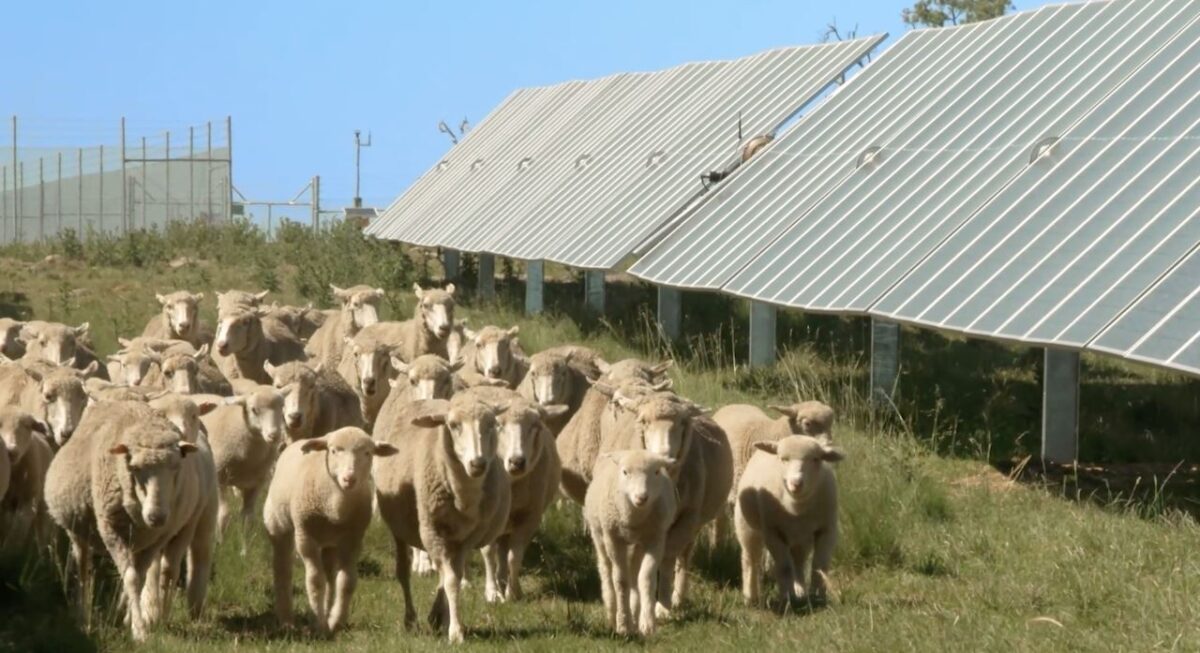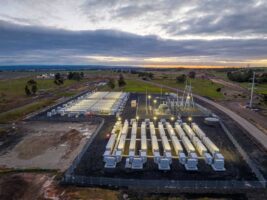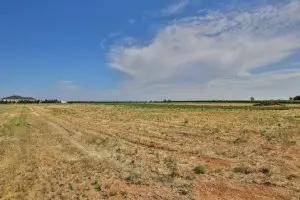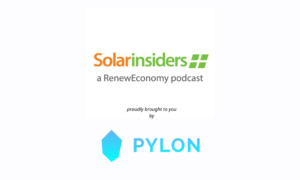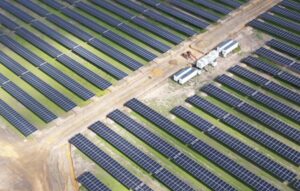Solar grazing isn’t a reality in Australia yet, but farmer-turned vegetation managers are pricking up their ears at the US-born concept.
But to make it work in Australia will require a few changes to the American model, which sees flocks rented out to solar farms to keep the grass down.
Sheep rentals to solar farms is now big, big business in the US. One market analyst suggested it is growing around 10 per cent every year and be worth $9.3 billion in 2031.
In fact, thanks to backing from Wall Street investors for solar vegetation management companies, solar grazing may be reversing a decades-long decline in the US sheep industry, according to Financial Times reporting.
“We definitely would be interested in it, because I assume if you’re renting out a mob of sheep to the solar farms [you] would be getting paid,” says Dan Maloney, one half of Fontenoy Project Group, a solar farm vegetation management company out of the New South Wales (NSW) town Wagga Wagga.
“For us to do [flock rentals],the farms would need constructed differently. You need to make sure all the wires are secure. There’s different ways the tracker systems work and sometimes they can be a hazard for stock, and the people working in there have to be aware of how to act around stock.
“One of the major things would be to make sure you’re not liable, say if a sheep chews through a wire and causes a heap damage.”
In the US, the industry even has a trade body – the American Solar Grazing Association – which put the number of rented flocks at 80,000 sheep across 500 solar farms in 27 different states.
Those figures, from April 2024, are likely to be even larger now after the Texas Sheep Co signed on with Enel North America to send out some 6,000 sheep to eight Texas solar farms, covering some 10,00 acres.
Vegetation management has been a natural progression for US farmers who start grazing on solar farms, found a survey by Bock Agricultural Law and Policy Program at the University of Illinois last year.
The survey found contracts delivered annual revenue of $US300 to $US500 per acre of solar site for farmers-turned solar grazers, after accounting for the investment in stock, transport, insurance and labour costs.
Australian farmers are thinking different
In Australia, grazing deals tend to be contra arrangements: I graze my sheep under your solar panels, reaping the benefits of heightened grass growth from the extra moisture that comes off dewy panels and shading, and you get the benefits of lower mowing costs.
Yet the attitude among solar farm developers and operators is still to charge farmers for using the land for grazing.
But interest in solar grazing is rising as farmers move into vegetation management services after going through the same experience as US farmers — they start out running sheep on a new solar farm on their land or their neighbour’s land, and then take the logical next step.
For example, Moloney and his cofounder started the Fontenoy Project Group venture after hosting the 30 megawatt (M) Junee solar farm, and branched out to manage vegetation at three others.
American experts are also visiting to explain the concept, with Jess Gray, the CEO of one of the biggest US solar grazers Gray’s Lambscaping, touring Australia in February.
In the same NSW region as Moloney is Solar Farming Solutions, run by farmers Ryan McGoldrick and Steve Hogan.
They look after 18 solar farms in NSW and up to Chinchilla in Queensland but only run sheep – Merino wethers and Dorper ewes – on the neighbouring 189 MW Coleambally solar farm and the 333 MW Darlington Point solar farm.
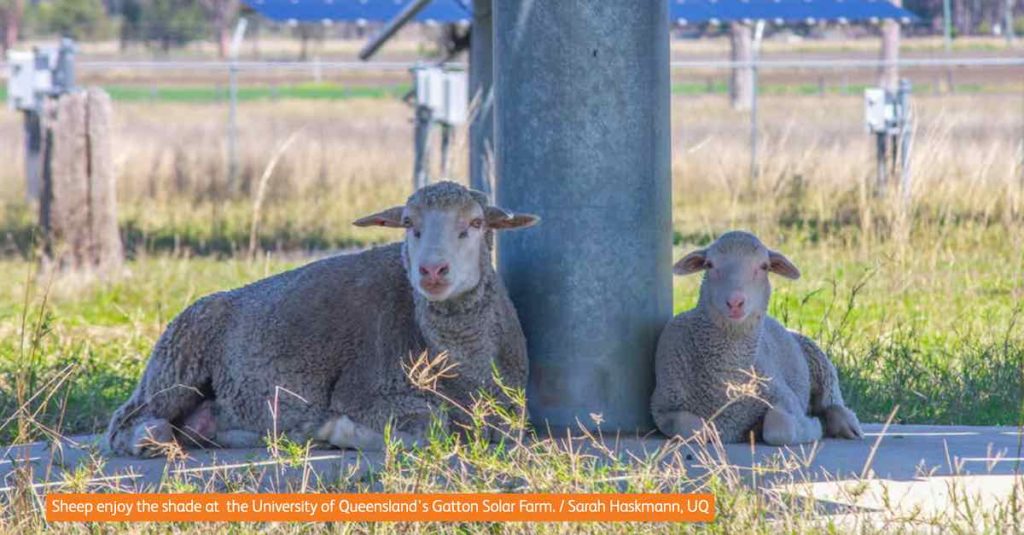
“During the drought years we started up a mowing business for the solar farms because we saw there was a need, as all these farms were getting built but the after-thought of vegetation management had been neglected,” McGoldrick says.
He says the sheep cut mowing costs by about a third, avoid one full mow a year, and keep the land in agriculture.
But again, while McGoldrick is interested in the idea of flock rentals and that was the original concept, they are not quite in that business yet.
Solar developers need to change their practices
Running sheep under solar panels is not as simple as just building a solar farm and letting animals roam.
Hogan says if flock rentals are to take off in Australia solar farms need to be set up from the start for sheep, and this means water systems, the ability to divide the massive areas up with fences, and yards for moving and handling stock.
His reservation about sending stock out for solar farm grazing is that Australia’s vastness means checking on his sheep – which must be done every few days – becomes difficult.
Longer term grazing is better done by local farmers but Hogan might consider sheep rentals for shorter term arrangements, with the proviso that transport costs would then come into the bill for the solar farm owner.
Australian solar developers are still not factoring agrisolar into system planning, despite putting it all over their environmental impact statements, says NSW farmer and agrisolar advocate Ben Wynn.
And this is making running sheep under solar panels challenging, period, let alone opening a door for a new vegetation management industry.
“To create better agricultural functionality we need to move to 2P systems… A tracker that pivots at 2-2-2.4 metres apart so a row of 12m and good clearance at midday,” he says.
“Until such time that we move to that type of infrastructure, in my view your capacity to run sheep effectively and maintain that good connection to agri functionality of your land is compromised.”
Wynn says sheep can get trapped underneath 1P tracking systems, which consist of a single portrait-sized panel rather than two, and solar farms designed to include animals will ensure there are no mechanical parts for sheep to get caught in.
Wynn is part of a group opposing the 320 MW Middlebrook solar farm south of Tamworth in NSW, because the current system design won’t allow for shared land use.
“It’s just got to be done properly and designed for both agricultural benefits and solar production. And if you do it properly it can be fantastic,” he says.
Moves afoot to formalise agrisolar
What might kick start a flock rental industry in Australia is an upcoming document from EnergyCo – again in NSW – which aims to lay out some ground rules for agrisolar.
The state renewable energy delivery platform is funding the design of technical regulations for landholders and developers around agrisolar practices. These will cover common mistakes, such as designing machinery so sheep can’t get caught up and including water troughs, as well as what farmers need to consider.
The guidelines are expected to be completed by the end of the year.
The technical guidelines should reduce animal welfare issues and create another opportunity for agriculturists keen on venturing into the new industry of solar grazing, says prominent agriculture consultant and spokesperson Karin Stark.
“I think it would be a good opportunity as one of the models offered to landholders who are open to agistment opportunities, or making additional profit from their sheep,” she says.
“It’s such early days with these types of businesses and trying to get it right across different types of farming businesses, we don’t have enough types of options in those companies to suit the different farming objectives… We need to be making sure that all of the different options are out there.”
Whether it’s solar grazing or simply keeping ‘prime agricultural land’ in use, the concept of flock rentals is appealing to farmers venturing into the new business of vegetation management.
“Sheep don’t eliminate all of the grass but they take the bulk out of it so if there is a fire it’s not too intense,” Hogan says.
“We started as farmers and we can see the need for a lot of these places to still be farmed.”

